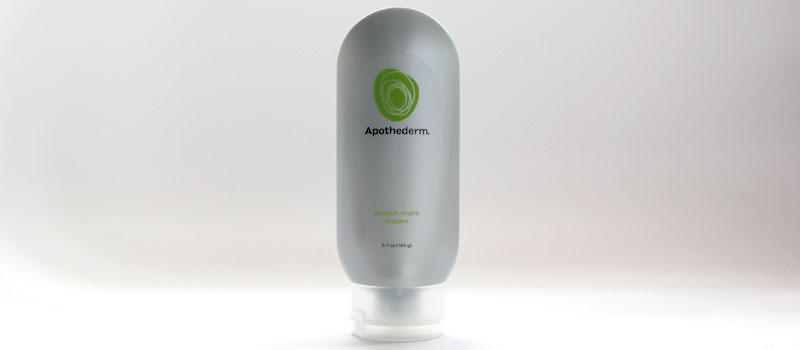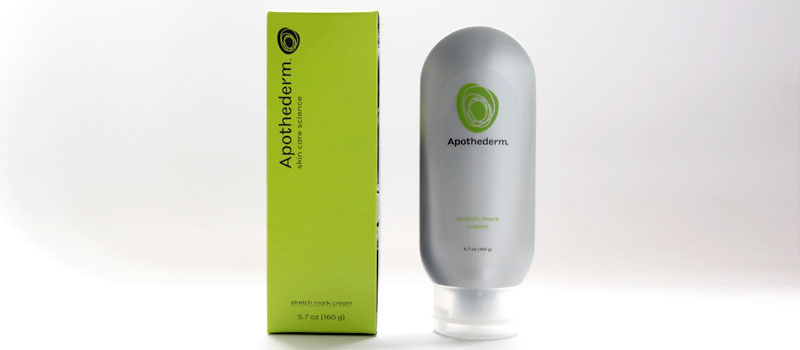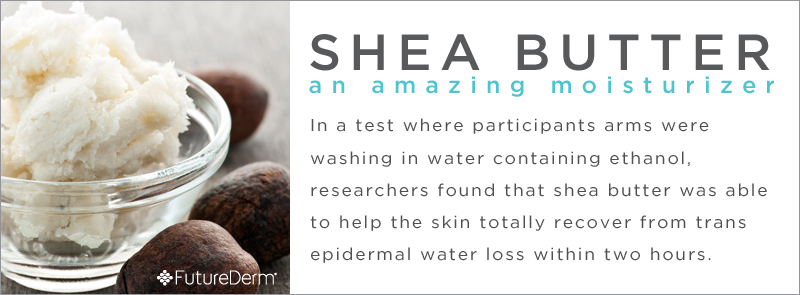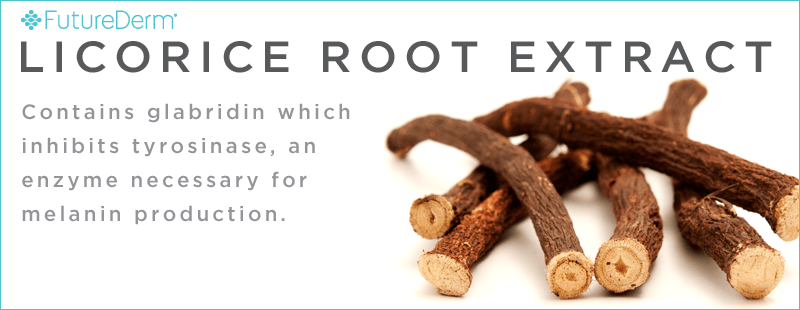As I get older (I’ll be 30 in November), my friends are having more and more babies. In turn, questions have turned from, “Which eye cream should I use?” to “How do I get rid of these stretch marks?!”
Of all of the treatments I have evaluated for FutureDerm, Apothederm Stretch Mark Cream ($89.95, FutureDerm.com/Shop) is amongst my favorites.
Why You Get Stretch Marks
Stretch marks are often seen following puberty and pregnancy, as well as in chronic yo-yo dieters and body builders. The exact mechanism by which stretch marks develop is unknown, but may occur when the maximum tensile strength of elastic fibers within the skin is exceeded, causing them to undergo stress.
It has been shown that stretch marks contain decreased amounts of fibrillin and elastin fibers, and an increase in glycosaminoglycans (British Journal of Dermatology, 2008). The study also showed stretch marks have disorganized fibrillin and elastic fibers.
An the ideal stretch mark treatment would cause fibrillin and elastin fibers to grow in higher numbers and to reorganize themselves. This is why laser treatments are so effective in treating stretch marks: A 1996 Dermatologic Surgery study showed a 585 nm laser increases collagen and elastin production within the skin. Lasers do this by stimulating cells called fibroblasts, which are responsible for collagen and elastin production. In a treatment like Apothederm Stretch Mark Cream, regular use of heptapeptide-7 is designed to increase collagen and elastin production over time.
Heptapeptide-7: May Stimulate Collagen and Elastin Production, Fighting Stretch Marks
Heptapeptide-7 is a fragment of a well-characterized wound healing peptide (HB-107). In at least one clinical study, heptapeptide-7 was found to stimulate keratinocyte proliferation and migration and induce collagen synthesis, when used in reasonable concentration on humans (Biomedsearch.com).
What does this mean for your stretch marks? According to Apothederm, a leading dermatologist-lead study resulted in the following:
- 70% of participants experienced the first signs of visible improvement in stretch marks in 14 days
- 90+% of participants saw overall improvement after 12 weeks of continued use
The study was based on 30 subjects and included new and old stretch marks as well as red and silver stretch marks (Apothederm.com).
Shea Butter: Used During and After Pregnancy for Thousands of Years Because it Hydrates and May Build Collagen
Shea butter is used so commonly, it makes me think it’s an old wives’ tale that it works. Since the days of Cleopatra, we’ve had histories that include shea butter for cosmetic usage (Shea Butter)! You would think that we would’ve discovered something better in the past 2000 years or so.
But shea butter has stuck around because it works.
First, shea butter is fantastic at retaining your skin’s moisture. It’s also been shown to be superior to mineral oil at preventing transepidermal water loss (TEWL). In a test where participants arms were washing in water containing ethanol, researchers found that shea butter was able to help the skin totally recover from TEWL within two hours. After three to four hours, it improved skin barrier (Formulation and Science). In one study, a cream with 5% shea and a placebo cream were applied to volunteer’s forearms. The moisturizing effects peaked at one hour but continued for eight hours (Pobeda and Sousselier). One study even showed that it worked as an emollient for eczema. Using a scale from zero to five — zero denoting clear and five denoting very severe disease — shea butter took a three down to a one, while Vaseline only took a three down to a two (Journal of Allergy and Clinical Immunology).
Second, shea butter has some exceptional anti-aging properties. In two studies it was determined to help regenerate thinning skin, lessen wrinkles from sun damage, improve complexion, and promote healing (Pobeda and Sousselier). The anti-aging, potentially collagen-boosting effects were attributed to the presences of unsaponifiables, lipids found in fatty fruits like avocado. In a study with rats, these were shown to boost collagen production (British Journal of Dermatology). Unsaponifiables in avocado and soybeans have been shown, not simply to reduce wrinkles through hydrating effect, but to actually increase collagen production (Phytotherapy Research).
Third, several studies suggest shea butter it has anti-inflammatory powers. It will reduce reactions to skin irritants (British Journal of Dermatology). It’s also been shown to aid in nasal congestion (Pobeda and Sousselier). But most studies should be done to determine exactly how effective it is for soothing inflammation.
However, shea butter is not yet established clinically to fight stretch marks (Mayo Clinic). Despite this, together with the heptapeptide-7 in Apothederm Stretch Mark Cream, shea butter should still work to combat stretch marks, providing hydration and a mild collagen-building boost.
Licorice Root Extract: Anti-Irritant, May Produce Mild Skin Lightening
Typically used in skin-brightening products, licorice root extract is included in Apothederm Stretch Mark Cream to help combat dark spots and discoloration. In Apothederm Stretch Mark Cream, it is added with the belief that it may help to combat the white, red, or brown nature of stretch marks.
The belief that licorice root extract may combat skin discoloration comes from its active component, glabridin. In varied studies, glabridin demonstrates skin-lightening properties similar to hydroquinone (HQ), interfering with the same enzyme responsible for melanin (skin pigment) formation, tyrosinase (Pigment Cell Research). Unlike HQ, glabridin does this without the mediation of DNA synthesis (Pigment Cell Research), so there is the potential for all of the benefits of HQ, without the potential discoloration or irritation associated with it. However, creams do not contain concentrated glabridin, only glabridin-containing licorice root extract, so a 1% HQ serum is still much more potent than a 1% licorice root extract in lightening the skin.
Still, even as pure licorice root extract, a 1% and 2% licorice gel demonstrated a statistically significant reduction of swelling, itchiness, and redness (think anti-inflammatory) of those with atopic dermatitis (Journal of Dermatological Treatment). A recent study with 30 test subjects similarly found that a cream with 2% licorice concentration helped reduce the appearance of eczema (NYU Langone Medical Center), meaning it may be helpful in reducing skin dryness, rashes and mild skin irritation.
Sodium Hyaluronate: Amazing Hydrator
One of my favorite skincare ingredients is sodium hyaluronate, which is one of the natural moisturizing factors (NMFs) found in the skin. Together with lipids, NMFs keep skin from losing water, maintaining skin’s young, smooth, non-flaky appearance.
In skincare products, natural moisturizing factors are able to draw water into the skin, reducing trans-epidermal water loss (TEWL), and creating a slight swelling of the skin that reduces the appearance of wrinkles. NMFs in skincare products also help to temporarily stabilize and maintain the complex intercellular-skin matrix, which is the “glue” that holds the skin together; this gives skin a smoother appearance (Begoun). Therefore, NMFs are often included in “anti-wrinkle” and “anti-aging” products, but they improve the appearance of the skin on a temporary basis more than they provide actual long-term correction of the skin, like retinoids. Despite their lack of long-term anti-aging benefits, NMFs may still be important for anti-aging prevention, as, according to Dr. Howard Murad, hydration of the skin with NMFs allows the skin to operate at optimum capacity, and provides a better defense against environmental assaults.
Other NMFs include glycerin, urea, alpha hydroxy acid, lactic acid, propylene glycol, and hyaluronic acid, which all prevent evaporation of products, increasing their shelf life. All of these NMFs are humectants, meaning that they are able to attract water from the atmosphere if atmospheric humidity is greater than 80 percent. However, when atmospheric humidity is lower than 80 percent, these NMFs may actually cause dryness, as they extract water from the deeper layers of the skin (Baumann). For this reason, these other NMFs work best when they are combined with occlusives like dimethicone or paraffin, as they are in most skincare formulations (Baumann).
That’s what I love about sodium hyaluronate: You don’t need a barometer to use it! Sodium hyaluronate is a particularly effective humectant because it is effective in both high and low humidity conditions. In its protonated acidic form (called hyaluronic acid), the compound can bind water up to 1000 times its volume (Baumann). However, sodium hyaluronate, with similar water-binding abilities, is commonly used instead of hyaluronic acid in skincare products due to its greater chemical stability (Kewpie). It is truly an amazing addition to Apothederm Stretch Mark Cream.
Personal Use and Opinions
Apothederm Stretch Mark Cream is a medium-to-thick white cream. It glides across the skin well and absorbs fairly well, within 5-10 seconds or so, depending on how much you apply. It does not have a scent. It leaves the skin feeling more hydrated and smoother, but not sticky or tacky at all. It is suitable for use during the day, under a broad-spectrum UVA/UVB sunscreen on exposed areas, as well as at night. I especially love it before bed, under 100% cotton pajamas, which helps the product sink in without sticking to it.
Other Products Recommended for Use After Pregnancy
Once you are done breast-feeding, I like Apothederm Stretch Mark Cream over top of a potent collagen-stimulating product with alpha hydroxy acid or retinoids.
I recommend either Dr. Dennis Gross Alpha Beta Peel Pads ($82.00, FutureDerm.com/Shop) on the stretch marks, followed by Apothederm Stretch Mark Cream, or our FutureDerm Time-Release Retinol 0.5 ($55.00, FutureDerm.com/Shop) or prescription retinoid directly on the stretch marks, followed by Apothederm Stretch Mark Cream.
Bottom Line

Apothederm Stretch Mark Cream is an excellent stretch mark treatment, featuring what may be a potent collagen builder, heptapeptide-7; skin-brightening licorice extract; and potent hydrators like olive oil, shea butter, and sodium hyaluronate. With a fantastic texture and soothing quality, Apothederm Stretch Mark Cream is perfect for twice-daily use to combat stretch marks, especially in conjunction with an AHA or retinoid.
Product Rating: 9/10 (High concentration of proven-effective ingredients: 3/3. Unique formulation or new technology: 3/3. Value: 3/3. Sunscreen: 0/1).
Directions
Apply morning and evening in a circular motion to areas with stretch marks. Allow the cream to dry before putting on clothes. Keep out of eyes.
Ingredients in Apothederm Stretch Mark Cream
Water, glycerin, butyrospermum parkii (shea butter) limnanthes alba (meadowfoam) seed oil, cetyl alcohol, glyceryl stearate, cyclopentasiloxane, PPG-3 benzyl ether myristate, tocopheryl acetate, theobroma cacao (cocoa) seed butter, sodium hyaluronate, sodium stearoyl glutamate, panthenol, pichia/resveratrol germent extract, glycyrrhiza glatra (licorice) root extract, olea europaea (olive) fruit oil, bisabolol, glucosamine HCL, algae extract, yeast extract, heptapeptide-7, glycine, alanine









